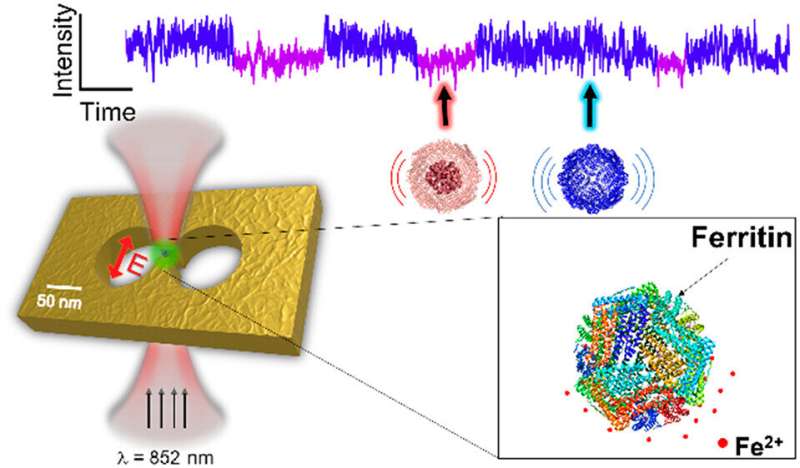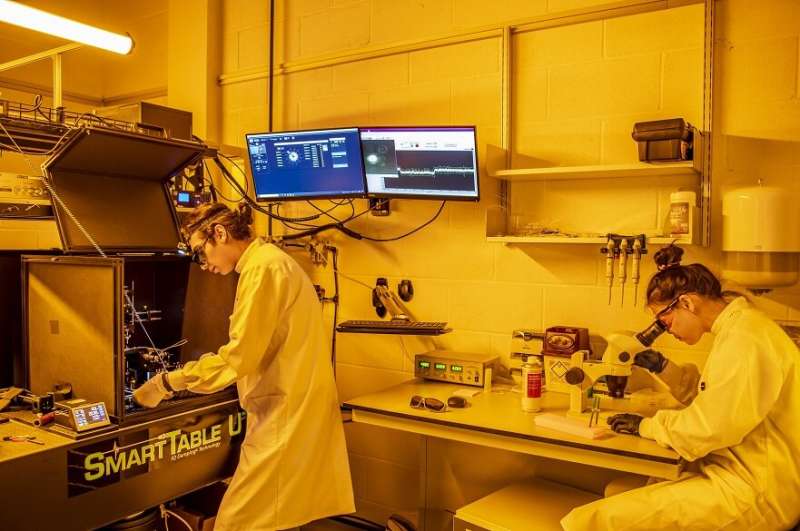This article has been reviewed according to Science X's editorial process and policies. Editors have highlighted the following attributes while ensuring the content's credibility:
fact-checked
peer-reviewed publication
trusted source
proofread
New technology to isolate and study a single protein paves way to improving understanding of disease processes

Scientists have developed new technology which has made it possible to isolate and study how a single protein—10,000 times thinner than a human hair—behaves and changes over time.
The Nottingham Trent University team says the work—the first of its kind—enables them to see how a protein behaves in its natural environment and that it could help better understand proteins linked to disease and how they might respond to certain therapies.
The research involves using a very high concentration of light which, when the beam is transmitted through a specifically engineered nano structure, generates the right amount of force to grasp and hold a single protein within the fluid without damaging it.
The technology is able to detect how the light is scattered and the researchers can analyze this unique data to reveal how the protein is behaving in real-time.
The protein is studied in its natural liquid environment, as the team's technique can mimic the body by altering factors such as salt concentration, pH, or oxygen levels.
As a proof of concept the researchers studied ferritin, a protein in the blood which stores and releases iron to prevent diseases associated with iron dysregulation, such as anemia.
During the study they were able to distinguish between the ferritin with iron and without—as the data revealed differences in their weight and movement—and even the point at which the ferritin without iron began capturing and storing iron.
They say that the study has deepened understanding of the iron uptake mechanism of ferritin proteins, which could lead to new therapeutics for iron-related diseases.
Until now, studies of ferritin have only been able to use ensemble measurements to quantify the characteristics of a large number of proteins, which provides limited information about their structural changes.
The researchers argue that because protein changes occur before symptoms in illness, their work could make it possible to identify and treat a range of diseases much earlier.
"To be able to see things beyond your eyesight, you first need the right technology. Our nanostructure enables us to observe proteins at the nano-scale," said lead researcher Dr. Cuifeng Ying from Nottingham Trent University's School of Science and Technology.
She said, "This technique allows us to study the behavior of a single living protein by using a high intensity light beam to trap, hold and study it in its own environment. Normally you'd need to study many proteins together to see how the group responds.
"Lots of proteins are linked to disease; if we can see the root problem then we can potentially treat them better and earlier."

Arman Yousefi, a Ph.D. candidate at Nottingham Trent University, and the first author of this study, said, "The scattered light provides us with a unique fingerprint to show us how the protein is behaving. With regards to ferritin, we observed the rigid and relaxed state of the protein with and without iron and even the process of collecting and storing the iron from its environment."
Mohsen Rahmani, Professor of Engineering at NTU and a Royal Society Wolfson Fellow, added: "This technology and technique give us the potential to identify protein changes in relation to disease emergence and progression. We can look at lots of proteins and see how they react to different drugs. In the future this breakthrough could play a key role in improving survival rates and reducing healthcare costs.
"There has previously been no tool to enable us to study proteins in this way without destroying them.
The study, which also involved the University of Nottingham and the Adolphe Merkle Institute at the University of Fribourg in Switzerland, is published in the journal Nano Letters.
More information: Arman Yousefi et al, Optical Monitoring of In Situ Iron Loading into Single, Native Ferritin Proteins, Nano Letters (2023). DOI: 10.1021/acs.nanolett.3c00042
Journal information: Nano Letters
Provided by Nottingham Trent University




















